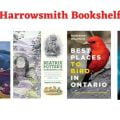A memory that will be forever etched in my mind.
A photograph is a moment in time. It is focused. Sharp. Its geometry can be perfect. A geometry that draws the eye. If a photograph connects with you, it has meaning to you. From this logic I was drawn to the photograph that I took of an American goldfinch. I am not a birder, but I do appreciate all the wonders of Nature, including a quick glimpse of a skittish raptor.
With a homemade feeder hanging from a branch at the bottom of a big red spruce tree in the front of our home in Moncton, New Brunswick, birds enjoy a little black-oil sunflower seed during the cold winter months. Black-capped chickadees are usually the first to discover the cache, and then other birds soon join in the pleasure like the blue jay, the nuthatch and the house finch.
Birds are excellent foragers. There is never a need to feed birds. If you take the time to watch them, you see them constantly hunting for insects, seed, fruit, and in some instances, sap, to power through the dog days of summer, and the cold bite of winter in February. And once their belly is full, birds cache every bit of extra food in trees, in soil, and yes, possibly even your patio furniture!
Nuthatches will drive bird seed into cracks in the bark of firs, with the help of their back, neck and tiny beak as their talons keep them anchored in place. Chickadees will sneak bird seed in the tight curls of the loose bark of the paper birch during the winter, where they sneak for insects in the summer and fall.
At home, away from nature preserves and the wild forests that stretch across Canada, birds find other places to cache seed, like siding and flower beds. We have a flower bed in the front of the house where the soil remains exposed throughout most of the year thanks to the canopy of the big red spruce. We’ve been cultivating this bed with perennials, such as butterfly flowers, cone flowers and black-eyed Susans along with many others, to offer a small gift of food to the birds and the bees. The flower bed is work in progress. So during the spring of 2020, as the sun and heat helped support the growth of these flowers, to my surprise, other unintended plants emerged. Four sunflower plants sprouted up from the ground shooting up towards the sun as they have done so for centuries. I didn’t think much of it at the time, and let them push on, even if they didn’t follow the regular pattern of the flowers we had planted. In the end, our dream was to create a naturel oasis for insects and birds to feed on, for added enjoyment, as we watched the flowers blossom into the colours of the rainbow.
The sunflowers continued growing throughout the summer outcompeting most of the perennials we had planted. One summer day, Josanne, my wife, asked me why I had planted sunflowers so sporadically across the flower bed. I simply answered, it wasn’t me, it was the birds. We both smiled at the thought of our little friends helping us create the beauty of the flower bed.
That summer, these four sunflowers, one with two flowers, reached three feet tall, and eventually the green buds opened up into an explosion of bright yellow, smiling at the people that walked passed them along the sidewalk. A bit of joy during a global pandemic.
And on a midsummer day, as we sat in the living room tucked away from that heat, and I sipped on an afternoon coffee, a bright yellow feathery streak of light drew my attention to one of the sunflowers that was dancing just outside the picture window. An American goldfinch was perched on the sunflower plucking away at the petals tossing them left and right. And when all looked safe to proceed, the goldfinch leaned forward and plucked away at the sunflower seed, not yet ripe, but available for the taking! As it crunched down to split the shell from the seed to fill its belly, I ran to the bedroom for my camera and shot towards the side door, but ever so quietly closed it behind me. Like a bobcat stocking its prey, I readied the camera and moved towards the corner of the house. As I held my breath and came forward from my blind, I eased into the front of the house where I drew the camera up to my eye, focused and snapped ten photographs. Not many, but maybe enough. Goldie looked at me suspiciously and flew into the big red spruce to carefully survey this unintended disruption, only to return once I was gone.
And in that fleeting moment this photograph will be forever etched in my mind. The bewilderment, the excitement, the joy and the satisfaction of that moment will always remain. A bird, that sowed a seed, that grew into a flower, to feed a bird, a lasting memory.














